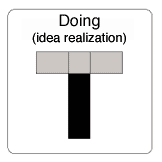Thinking, Linking, Doing
If you’ve been following Chris Anderson’s excellent blog about The Long Tail you know that he places a high level of importance on the idea of “filters”. Filters, as he defines them, are trusted aggregators, like Amazon and Google, which use smart software to help you find the good stuff, but can also be individual tastemakers, from celebrities to critics to editors to simple mavens with influential blogs. (Branding folks would be well advised to read Anderson’s take on how information is increasingly serving the same role as a brand.) Filters make the long tail possible and potentially profitable by finding, organizing and even recommending the extensive variety and niche appeal of non-hits.
In the same way that filters make vast catalogues of music, books, advertising, and videos accessible and applicable to consumers and researchers, filters play an essential role in transforming ideas into creative endeavour. If ideas are plentiful, random and diverse, and creativity defined, iterative and focused, there is a very real value in the translation from general to specific.
There are three stages, I believe, to realizing ideas: thinking, linking, and doing.
 The Thinking stage is the one I dwell on most here at Creative Generalist. This stage involves observation, blue sky brainstorming, and a wide open divergent approach to problem solving. Reconnaissance. Inspiration. Possibilities. It’s also the stage most often overlooked or outright excluded in business. As I’ve repeated many times, there just aren’t that many organizations that can wander without boundaries, span industries and disciplines, and see relationships between disparate unconventional, obscure or uncommon things. But they should.
The Thinking stage is the one I dwell on most here at Creative Generalist. This stage involves observation, blue sky brainstorming, and a wide open divergent approach to problem solving. Reconnaissance. Inspiration. Possibilities. It’s also the stage most often overlooked or outright excluded in business. As I’ve repeated many times, there just aren’t that many organizations that can wander without boundaries, span industries and disciplines, and see relationships between disparate unconventional, obscure or uncommon things. But they should.
 The middle stage, Linking (or creativity sourcing), requires a matchmakers mentality combined with the ability to recognize how ideas could be most applicable in the real world and then set out to find and facilitate the connection with the appropriate executional specialist. They also maintain a balance between trying new ideas and satisfying everyday practicalities. This integral spanning stage facilitates the shepherding of a project that begins with relatively little standardization into a standardized system that can bring goals to life. It’s at this stage that I think versatilists — those with a hybrid generalist-specialist mindset — offer the most value. It’s also a stage increasingly aided by filtering or aggregating software.
The middle stage, Linking (or creativity sourcing), requires a matchmakers mentality combined with the ability to recognize how ideas could be most applicable in the real world and then set out to find and facilitate the connection with the appropriate executional specialist. They also maintain a balance between trying new ideas and satisfying everyday practicalities. This integral spanning stage facilitates the shepherding of a project that begins with relatively little standardization into a standardized system that can bring goals to life. It’s at this stage that I think versatilists — those with a hybrid generalist-specialist mindset — offer the most value. It’s also a stage increasingly aided by filtering or aggregating software.
 The last stage of this ideative-creative conduit is where rubber meets the road. Best left to specialists, the Doing stage involves highly creative executional work that frequently requires many innovations along the way.
The last stage of this ideative-creative conduit is where rubber meets the road. Best left to specialists, the Doing stage involves highly creative executional work that frequently requires many innovations along the way.
The importance of the intermediate Linking stage cannot be emphasized enough. To create, one must have an idea and to have an idea, one must create. If idea generation revolves around a generalist approach that has a problem in need of a solution, and idea realization revolves around a specialist approach that has a solution in need of a problem, there becomes a vital role for snapping these two pieces together. The fluid nature of both the input and output ends — that is, the ideas and the creative solutions — of their projects is dramatic and constantly changing. And because of the dynamic nature of both the generation and the realization stages, the linking stage is far from a passive one.
The infamous 1970 space flight of Apollo 13 required some ingenious “finding” skills from its mission control engineers when they learned that the craft’s air filtration system was failing. Made famous by a scene in the 1995 Tom Hanks movie, the engineers gathered in a room and pored over all of the typical materials that the astronauts would have on board and would need to fit an alternate filter to the oxygen source. They were literally working with a square peg and a round hole, both of which were effectively useless without being connected to the other. The resulting patchwork of clipboard parts, socks, and duct tape was an essential, life-saving transitional piece.







Leave a Reply